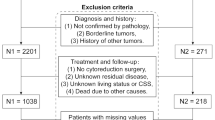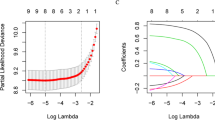Abstract
Objective
To construct a nomogram of individual risks from exploratory clinicopathological features associated with platinum-resistant/refractory epithelial ovarian cancer (EOC).
Methods
Patients who were diagnosed with EOC stage IA-IB, grades 2–3, and greater than stage IC, from January 1, 2005, to December 30, 2013, after the debulking of the tumors, were studied retrospectively. Additionally, they had received adjuvant treatment with a paclitaxel-carboplatin regimen at Songklanagarind Hospital. The patients’ data (demographic, surgical, laboratory, pathological results, and clinical outcomes) were collected. The clinicopathological features associated with platinum-refractory/resistant EOC were assessed using univariate and multivariate logistic regression analyses. Significant factors were used to construct a nomogram; the nomogram predictive accuracy was measured via a concordance index (c-index) and validated using the bootstrap validation method.
Results
Of 235 patients included, the prevalence of platinum-resistant/refractory EOC was 19.1% overall and 36.8% for recurrent EOC. The clinicopathological features associated with platinumrefractory/ resistant EOC were parity, size of residual tumor, grade, International Federation of Gynecology and Obstetrics (FIGO) staging, platelet count, and number of cycles of chemotherapy. The nomogram c-index and mean absolute error were 0.83 and 0.03, respectively.
Conclusion
One-fifth of the women with EOC and one-third with recurrent EOC had platinum-refractory/resistant EOC. The clinicopathological features, including parity, size of residual tumor, grade, FIGO staging, platelet count, and number of cycles of chemotherapy, are useful as predictors of platinumrefractory/ resistant EOC. Patients with these significant factors and with a high probability of developing platinum-resistant/refractory EOC should be considered for close surveillance and be made aware of recurrent disease.


Similar content being viewed by others
References
International Agency for Research on Cancer, World Health Organization. Cancer today. Estimated age-standardized incidence and mortality rates (World) in 2020, worldwide, females, all ages; 2020. Retrieved from: https://gco.iarc.fr/today/online-analysis-multi-bars?v=2020&mode=cancer&mode_population=countries&population=900&populations=900&key=asr&sex=2&cancer=39&type=0&statistic=5&prevalence=0&population_group=0&ages_group%5B%5D=0&ages_group%5B%5D=17&nb_items=10&group_cancer=1&include_nmsc=1&include_nmsc_other=1&type_multiple=%257B%2522inc%2522%253Atrue%252C%2522mort%2522%253Atrue%252C%2522prev%2522%253Afalse%257D&orientation=horizontal&type_sort=0&type_nb_items=%257B%2522top%2522%253Atrue%252C%2522bottom%2522%253Afalse%257D [accessed 6 Nov 2021]. IARC and WHO
National Comprehensive Cancer Network. NCCN Clinical Practice Guidelines in Oncology: ovarian cancer including fallopian tube cancer and primary peritoneal cancer; 2021. Retrieved from: https://www.nccn.org/guidelines/guidelines-detail?category=1&id=1453 [accessed 26 Febr 2021]
Ledermann JA, Raja FA, Fotopoulou C, Gonzalez-Martin A, Colombo N, Sessa C. Newly diagnosed and relapsed epithelial ovarian carcinoma: ESMO clinical practice guidelines for diagnosis, treatment and follow-up. Ann Oncol. 2013;24:vi24-32. https://doi.org/10.1093/annonc/mdt333.
Lawrie TA, Winter-Roach BA, Heus P, Kitchener HC. Adjuvant (post-surgery) chemotherapy for early stage epithelial ovarian cancer. Cochrane Database Syst Rev. 2015. https://doi.org/10.1002/14651858.CD004706.pub5.
Rizzuto I, Stavraka C, Chatterjee J, Borley J, Hopkins TG, Gabra H, et al. Risk of ovarian cancer relapse score: a prognostic algorithm to predict relapse following treatment for advanced ovarian cancer. Int J Gynecol Cancer. 2015;25:416–22. https://doi.org/10.1097/IGC.0000000000000361.
Nguyen TT, Wright JD, Powell MA, Gibb RK, Rader JS, Allsworth JE, et al. Prognostic factors associated with response in platinum retreatment of platinum-resistant ovarian cancer. Int J Gynecol Cancer. 2008;18:1194–9. https://doi.org/10.1111/j.1525-1438.2007.01184.x.
Clark TG, Stewart ME, Altman DG, Gabra H, Smyth JF. A prognostic model for ovarian cancer. Br J Cancer. 2001;85:944–52. https://doi.org/10.1054/bjoc.2001.2030.
Barlin JN, Yu C, Hill EK, Zivanovic O, Kolev V, Levine DA, et al. Nomogram for predicting 5-year disease-specific mortality after primary surgery for epithelial ovarian cancer. Gynecol Oncol. 2012;125:25–30. https://doi.org/10.1016/j.ygyno.2011.12.423.
Pisano C, Bruni GS, Facchini G, Marchetti C, Pignata S. Treatment of recurrent epithelial ovarian cancer. Ther Clin Risk Manag. 2009;5:421–6. https://doi.org/10.2147/tcrm.s4317.
Armstrong DK. Relapsed ovarian cancer: challenges and management strategies for a chronic disease. Oncologist. 2002;7(Suppl 5):20–8. https://doi.org/10.1634/theoncologist.7-suppl_5-20.
Parmar MK, Ledermann JA, Colombo N, du Bois A, Delaloye JF, Kristensen GB, et al. Paclitaxel plus platinum-based chemotherapy versus conventional platinum-based chemotherapy in women with relapsed ovarian cancer: the ICON4/AGO-OVAR-2.2 trial. Lancet. 2003;361:2099–106. https://doi.org/10.1016/s0140-6736(03)13718-x.
Mahner S, Meier W, du Bois A, Brown C, Lorusso D, Dell’Anna T, et al. Carboplatin and pegylated liposomal doxorubicin versus carboplatin and paclitaxel in very platinum-sensitive ovarian cancer patients: results from a subset analysis of the Calypso phase III trial. Eur J Cancer. 2015;51:352–8. https://doi.org/10.1016/j.ejca.2014.11.017.
Gerestein CG, Eijkemans MJ, de Jong D, van der Burg ME, Dykgraaf RH, Kooi GS, et al. The prediction of progression-free and overall survival in women with an advanced stage of epithelial ovarian carcinoma. BJOG. 2009;116:372–80. https://doi.org/10.1111/j.1471-0528.2008.02033.x.
Lee CK, Simes RJ, Brown C, Gebski V, Pfisterer J, Swart AM, et al. A prognostic nomogram to predict overall survival in patients with platinum-sensitive recurrent ovarian cancer. Ann Oncol. 2013;24:937–43. https://doi.org/10.1093/annonc/mds538.
Lee CK, Simes RJ, Brown C, Lord S, Wagner U, Plante M, et al. Prognostic nomogram to predict progression-free survival in patients with platinum-sensitive recurrent ovarian cancer. Br J Cancer. 2011;105:1144–50. https://doi.org/10.1038/bjc.2011.364.
Classe JM, Jaffre I, Frenel JS, Bordes V, Dejode M, Dravet F, et al. Prognostic factors for patients treated for a recurrent FIGO stage III ovarian cancer: a retrospective study of 108 cases. Eur J Surg Oncol. 2011;37:971–7. https://doi.org/10.1016/j.ejso.2011.08.138.
Pitakkarnkul S, Tangjitgamol S, Srijaipracharoen S, Manusirivithaya S, Pataradool K, Prutthiphongsit W, et al. Treatment outcomes of paclitaxel for refractory or recurrent epithelial ovarian cancer patients in Thailand. Asian Pac J Cancer Prev. 2013;14:2421–7. https://doi.org/10.7314/apjcp.2013.14.4.2421.
International Agency for Research on Cancer, World Health Organization. CI5 plus Cancer Incidence in five Continents Time Trends. Thailand (4 registries) Age Standardized Incidence Rate (World), Female Age [0–85+]; 2014. Retrieved from: http://ci5.iarc.fr/CI5plus/old/Graph4p.asp?cancer%5B%5D=50&cancer%5B%5D=110&cancer%5B%5D=152&cancer%5B%5D=162&cancer%5B%5D=172&cancer%5B%5D=182&female=2&country%5B%5D=76400000&sYear=1950&eYear=2012&stat=3&age_from=1&age_to=18&orientation=1&window=1&grid=1&line=2&moving=1&scale=0&submit=%C2%A0%C2%A0%C2%A0Execute%C2%A0%C2%A0%C2%A0 [accessed 6 Nov 2021]. IARC and WHO
International Agency for Research on Cancer, World Health Organization. Cancer today. Estimated age-standardized incidence and mortality rates (World) in 2020, ovary, females, all ages; 2020. Retrieved from: https://gco.iarc.fr/today/online-analysis-multi-bars?v=2020&mode=population&mode_population=countries&population=900&populations=900&key=asr&sex=2&cancer=25&type=0&statistic=5&prevalence=0&population_group=4&ages_group%5B%5D=0&ages_group%5B%5D=17&nb_items=20&group_cancer=1&include_nmsc=1&include_nmsc_other=1&type_multiple=%257B%2522inc%2522%253Atrue%252C%2522mort%2522%253Atrue%252C%2522prev%2522%253Afalse%257D&orientation=horizontal&type_sort=0&type_nb_items=%257B%2522top%2522%253Atrue%252C%2522bottom%2522%253Afalse%257D&population_group_list=4,51,31,48,50,64,96,116,160,275,268,356,360,364,368,376,392,400,398,408,410,414,417,418,422,458,462,496,104,524,512,586,608,634,682,702,144,760,762,764,626,792,795,784,860,704,887&population_group_globocan_id=935 [accessed 6 Nov 2021]. IARC and WHO
Nishino M, Jagannathan JP, Ramaiya NH, Van den Abbeele AD. Revised RECIST guideline version 1.1: what oncologists want to know and what radiologists need to know. AJR Am J Roentgenol. 2010;195:281–9. https://doi.org/10.2214/AJR.09.4110.
Zhang Z, Kattan MW. Drawing nomograms with R: applications to categorical outcome and survival data. Ann Transl Med. 2017;5:211. https://doi.org/10.21037/atm.2017.04.01.
Iasonos A, Schrag D, Raj GV, Panageas KS. How to build and interpret a nomogram for cancer prognosis. J Clin Oncol. 2008;26:1364–70. https://doi.org/10.1200/JCO.2007.12.9791.
Skírnisdóttir I, Sorbe B. Survival and prognostic factors in early-stage epithelial ovarian carcinoma treated with taxane-based adjuvant chemotherapy. Int J Gynecol Cancer. 2007;17:1231–7. https://doi.org/10.1111/j.1525-1438.2007.00928.x.
Rauh-Hain JA, Nitschmann CC, Worley MJ Jr, Bradford LS, Berkowitz RS, Schorge JO, et al. Platinum resistance after neoadjuvant chemotherapy compared to primary surgery in patients with advanced epithelial ovarian carcinoma. Gynecol Oncol. 2013;129:63–8. https://doi.org/10.1016/j.ygyno.2013.01.009.
Chi DS, Palayekar MJ, Sonoda Y, Abu-Rustum NR, Awtrey CS, Huh J, et al. Nomogram for survival after primary surgery for bulky stage IIIC ovarian carcinoma. Gynecol Oncol. 2008;108:191–4. https://doi.org/10.1016/j.ygyno.2007.09.020.
Shafrir AL, Babic A, Tamimi RM, Rosner BA, Tworoger SS, Terry KL. Reproductive and hormonal factors in relation to survival and platinum resistance among ovarian cancer cases. Br J Cancer. 2016;115:1391–9. https://doi.org/10.1038/bjc.2016.316.
Stone RL, Nick AM, McNeish IA, Balkwill F, Han HD, Bottsford-Miller J, et al. Paraneoplastic thrombocytosis in ovarian cancer. N Engl J Med. 2012;366:610–8. https://doi.org/10.1056/NEJMoa1110352.
Lin RJ, Afshar-Kharghan V, Schafer AI. Paraneoplastic thrombocytosis: the secrets of tumor self-promotion. Blood. 2014;124:184–7. https://doi.org/10.1182/blood-2014-03-562538.
Allensworth SK, Langstraat CL, Martin JR, Lemens MA, McGree ME, Weaver AL, et al. Evaluating the prognostic significance of preoperative thrombocytosis in epithelial ovarian cancer. Gynecol Oncol. 2013;130:499–504. https://doi.org/10.1016/j.ygyno.2013.05.038.
Bottsford-Miller J, Choi HJ, Dalton HJ, Stone RL, Cho MS, Haemmerle M, et al. Differential platelet levels affect response to taxane-based therapy in ovarian cancer. Clin Cancer Res. 2015;21:602–10. https://doi.org/10.1158/1078-0432.CCR-14-0870.
Acknowledgements
This research project was supported by a grant (EC 58–210-12–4) from the Faculty of Medicine, Prince of Songkla University. We would like to give sincere thanks to Ms.Nannapat Kaewmunee and Professor Alan Geater for calculating sample sizes and analyzing the data and the Department of International Affairs, for their editing of the grammar in this manuscript.
Funding
The authors are grateful to the Prince of Songkla University for enabling them to conduct the research (EC 58–210-12–4).
Author information
Authors and Affiliations
Corresponding author
Ethics declarations
Conflict of interest
All authors declare that they have no conflict of interest.
Ethics approval
This retrospective chart review study, involving human participants, was in accordance with the ethical standards of the institutional and national research committee. In addition with the 1964 Helsinki Declaration: its later amendments or comparable ethical standards. The Ethics Committee of the Faculty of Medicine, Prince of Songkla University (EC 58–210-12–4) approved this study.
Informed consent
The informed consent from the patients was not required because of the study’s retrospective nature.
Animals rights
This research did not involve any animals.
Additional information
Publisher's Note
Springer Nature remains neutral with regard to jurisdictional claims in published maps and institutional affiliations.
Rights and permissions
Springer Nature or its licensor (e.g. a society or other partner) holds exclusive rights to this article under a publishing agreement with the author(s) or other rightsholder(s); author self-archiving of the accepted manuscript version of this article is solely governed by the terms of such publishing agreement and applicable law.
About this article
Cite this article
Saeaib, N., Chaowanadisai, S. & Liabsuetrakul, T. Clinicopathological Nomogram for Predicting Platinum-Resistant/Refractory Epithelial Ovarian Cancer. Indian J Gynecol Oncolog 22, 60 (2024). https://doi.org/10.1007/s40944-024-00823-y
Received:
Revised:
Accepted:
Published:
DOI: https://doi.org/10.1007/s40944-024-00823-y




